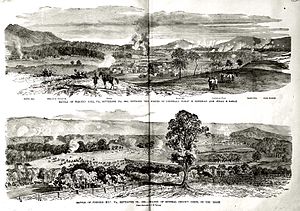Battle of Fishers Hill
| date | September 21 - September 22, 1864 |
|---|---|
| place | Warren County , Virginia , USA |
| output | Union victory |
| Parties to the conflict | |
|---|---|
| Commander | |
| Troop strength | |
|
29,444
|
about 9500
|
| losses | |
|
528 killed
: 52 wounded: 457 missing / captured: 19 |
1,235 killed
: 30 wounded: 210 missing / captured: 995 |
Guard Hill - Summit Point - Smithfield Crossing - Berryville - Opequon - Fishers Hill - Toms Brook - Cedar Creek
The Battle of Fishers Hill was an American Civil War battle in the eastern theater of war. It took place on September 21 and 22, 1864 in the Shenandoah Valley around the hamlet of Fishers Hill. The battle was crucial to the outcome of Sheridan's campaign in Shenandoah Valley.
Starting position
After the defeat at the Opequon south of Winchester - Third Battle of Winchester on September 19 - the Shenandoah Army under the command of Lieutenant General Jubal Anderson Earlys evaded south and took positions between the Massanutten and Little North Mountain. In the enemy direction, the Shenandoah and the Tumbling Run ran in front of the positions . The left part of the positions to Little North Mountain was occupied by a weak cavalry brigade, followed by the Ramseurs, Pegrams, Gordons and Whartons divisions to the south . The strong security line was on the hills in front of the positions. With the artillery, the southerners dominated all approaches south of the Middle Road (today's Interstate 81 ).
Sheridan's forces followed the Southerners after their success at Winchester and reached Strasburg, Virginia on September 20. From left to right the Confederates saw the XIX. Corps under the command of Major General Emory and the VI. Corps under Major General Wright, the VIII Corps Major General Crooks initially remained in reserve. Sheridan's troops also dug into the ground. A cavalry division was guarding the Back Road along the Little North Mountains.
Fight on September 21st
After violent skirmishes with the Confederates buried in the security line, the VI attacked. Corps to the security line and broke into the positions after two failed attacks. The Union soldiers now had a field of vision and field of fire with muskets and artillery on the Confederate positions at the Tumbling Run. During the night Sheridan brought more divisions into the starting position for the attack planned for the next day.
Fight on September 22nd
By noon all of Sheridan's divisions had taken their starting positions against fierce resistance from the Confederate. In the morning, VIII Corps of Crooks had reached the foot of the Little North Mountains and was advancing southwest along the wooded mountain, unnoticed by the Confederates.
At around 2:00 p.m., Sheridan Crook ordered the Confederate attack on the flank. Half of the corps was on the deep Confederate flank and had rarely received fire from the surprised southern guards. At 4:00 p.m. Crooks' divisions turned left and stormed down Little North Mountain. All order was quickly lost in the attack. Some southerners initially withstood the superiority, but when it became known that they had been bypassed, many gave up their positions. A counterattack failed because it passed the Union soldiers.
At the same time as Crook's corps, Sheridan ordered the other corps to attack as well. Rolled up from the flank and attacked head-on, the southerners fled, leaving behind equipment and 14 guns. In the general confusion, however, Early succeeded in rearguarding infantry and artillery, which was able to stop the now completely uncoordinated attack by the Northerners.
Apart from the battle, the Union cavalry had received the order to advance east of the Massanutten Mountains through the Luray Valley and to interrupt Early's connections to the rear. This was stopped by Southern cavalry at Overall, Virginia.
Effects
Early's divisions dodged as far as Waynesboro, 60 miles south, and left the Shenandoah Valley to the Union. The evasive southerners were not immediately pursued because the Union associations were completely confused. The Shenandoah Valley was in Union hands as far as Staunton , Virginia. When Sheridan had to make his way northeast through the valley in October, he used the scorched earth tactic .
literature
- James M. McPherson : Battle Cry of Freedom . Oxford University Press, New York 2003, ISBN 0-19-516895-X .
- James M. McPherson (Ed.): The Atlas of the Civil War . Philadelphia 2005, ISBN 0-7624-2356-0 .
- James M. McPherson: Die for Freedom. The history of the American Civil War, Anaconda Verlag Cologne, ISBN 978-3-86647-267-9 .
- Shelby Foote : The Civil War, a narrative: 3. Red River to Appomattox . Random house Inc., New York 1986. ISBN 0-394-74622-8 .
- United States War Department: The War of the Rebellion: a Compilation of the Official Records of the Union and Confederate Armies , Govt. Print. Off., Washington 1880-1901.
